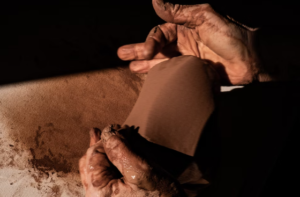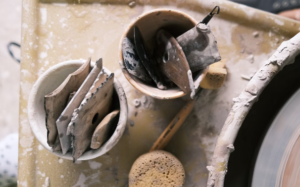Table Of Contents
- 1 Will Clay Stick to Canvas? Exploring the Possibilities and Challenges
- 1.1 Unveiling the Meaning: Unpacking the Factors Influencing Clay and Canvas Adhesion
- 1.2 1. Type of Clay:
- 1.3 2. Canvas Material:
- 1.4 3. Additional Factors:
- 1.5 4. “It Only Works if the Clay Goes All the Way Around and Connects to Itself”:
- 1.6 Bridging the Gap: Practical Techniques for Attaching Clay to Canvas
- 1.7 1. Preparing for Success:
- 1.8 2. Choosing the Right Adhesive:
- 1.9 3. Bonding Techniques:
- 1.10 4. Finishing Touches:
- 1.11 5. Artistic Exploration:
- 1.12 Remember:
- 1.13 Conclusion: A Lasting Bond Between Clay and Canvas
- 1.14 Frequently Asked Questions (FAQs):
- 1.15 Q: What type of clay is best for attaching to canvas?
- 1.16 Q: How long does it take for clay to dry on canvas?
- 1.17 Q: What can I do if the clay cracks after drying?
- 1.18 Q: Where can I find more information and inspiration for clay and canvas projects?
- 1.19 Conclusion:
Will Clay Stick to Canvas? Exploring the Possibilities and Challenges
The question “will clay stick to canvas?“ is a common one among artists and crafters intrigued by the creative possibilities of combining these two materials. While clay offers a versatile and moldable medium for sculpting and creating three-dimensional forms, the relatively flat and flexible surface of canvas presents a unique challenge for achieving a secure and lasting bond.
In this first session, we’ll embark on a journey to explore the intricacies of this interaction. We’ll delve into the factors that influence the adhesion of clay to canvas, examining the characteristics of different types of clay and the various canvas materials available. We’ll also uncover the key techniques and considerations needed to create successful artistic expressions with this intriguing material combination.

Unveiling the Meaning: Unpacking the Factors Influencing Clay and Canvas Adhesion
The statement “it only works if the clay goes all the way around and connects to itself” encapsulates the central challenge of adhering clay to canvas. Unlike attaching clay to a solid, three-dimensional object, the flat and flexible nature of canvas offers limited points of contact. This can lead to the clay detaching over time, especially under pressure or stress.
However, understanding the factors influencing adhesion empowers us to overcome this challenge. Here’s a breakdown of key elements to consider:
1. Type of Clay:
- Air-dry clay: Known for its natural stickiness, air-dry clay readily adheres to canvas surfaces, particularly when primed with acrylic gesso. However, its strength may be insufficient for heavier clay applications.
- Polymer clay: Unlike air-dry clay, polymer clay requires baking to harden and exhibits minimal natural adhesion to canvas. To achieve a strong bond, artists can utilize a strong adhesive, such as epoxy, or score the canvas surface to increase its surface area.
- Earthenware and stoneware: These clays possess minimal stickiness and require additional support to adhere to canvas. Methods like applying a strong adhesive, embedding the clay into the canvas, or directly firing the clay onto the canvas are employed to achieve a secure bond.
2. Canvas Material:
- Primed canvas: Canvas primed with acrylic gesso offers a slightly textured surface, enhancing the adhesion of air-dry clay. This provides a more secure foundation for sculpting and creating three-dimensional forms.
- Unprimed canvas: Unprimed canvas absorbs more moisture, potentially reducing the adherence of air-dry clay. Applying a primer before attaching clay becomes crucial in such scenarios.
3. Additional Factors:
- Surface preparation: Cleaning and roughening the canvas surface, regardless of its primed state, can significantly improve the adhesion of clay. This creates a more textured surface for the clay to grip onto.
- Adhesives: Utilizing a strong adhesive specifically formulated for clay adhesion, such as epoxy or liquid polymer clay, can provide an extra layer of security, especially for heavier clay applications.
- Embedding techniques: Embedding the clay into the canvas by carving grooves or drilling holes and inserting wire can further strengthen the bond and prevent the clay from detaching.
4. “It Only Works if the Clay Goes All the Way Around and Connects to Itself”:
This statement underscores the importance of creating a continuous and self-supporting clay structure when working with canvas. By ensuring the clay forms a closed loop or connects to itself at various points, the overall structure becomes more resilient and less susceptible to detaching from the canvas.
Understanding these factors provides a solid foundation for exploring the creative possibilities of using clay on canvas. By carefully considering the type of clay, canvas material, and additional techniques, artists can create unique and captivating artwork that transcends the limitations of traditional canvas painting.

Bridging the Gap: Practical Techniques for Attaching Clay to Canvas
Having unveiled the factors that influence clay adhesion to canvas, we now delve into the practical aspects of bringing your artistic vision to life. This session explores specific techniques and methods to confidently bridge the gap between these two seemingly disparate materials.
1. Preparing for Success:
- Cleanliness is key: Ensure both the clay and the canvas surface are free of dust, oil, and any residue that could hinder adhesion. Wipe the canvas with a damp cloth and gently sand the surface for additional texture.
- Prime time: Applying a coat of acrylic gesso to the canvas, especially for unprimed versions, creates a textured surface that enhances the adhesion of air-dry clay. Allow the primer to dry completely before proceeding.
2. Choosing the Right Adhesive:
Different types of adhesives offer varying strengths and suitability for different types of clay and canvas. Here’s a breakdown of some popular options:
- Craft glue: This readily available adhesive provides a good bond for lighter air-dry clay applications.
- Epoxy glue: Ideal for heavier clay objects and those subjected to frequent handling, epoxy offers superior strength and durability.
- Liquid polymer clay: This versatile material serves as both a sculpting medium and an adhesive, seamlessly transitioning between clay and canvas.
- Specialized clay adhesives: Certain adhesives specifically formulated for clay-to-canvas bond provide a reliable and strong connection.
3. Bonding Techniques:
- Direct application: For air-dry clay, applying a thin layer of adhesive to both the canvas and the clay surface and then gently pressing them together ensures initial adhesion.
- Embedding: For heavier clay or increased security, carving grooves or drilling holes into the canvas and inserting wire dipped in adhesive before attaching the clay creates a more robust bond.
- Scoring: Using a sharp tool to create cross-hatching patterns on the canvas surface increases surface area, providing additional grip for the clay.
- Multiple layers: Applying multiple thin layers of clay, allowing each layer to dry thoroughly before adding the next, ensures a stronger and more stable overall structure.
4. Finishing Touches:
- Drying time: Follow the drying instructions for your chosen clay and adhesive, allowing ample time for complete curing before adding any additional embellishments.
- Sealing and protection: Applying a sealant, such as acrylic varnish, helps protect your artwork from dust, moisture, and fading, ensuring its longevity.
5. Artistic Exploration:
By understanding and mastering these practical techniques, you can embark on a journey of artistic exploration with clay and canvas. Experiment with different clay types, textures, colors, and embellishments to create unique sculptures, bas-reliefs, mixed media artwork, and more. The possibilities are endless, limited only by your imagination!
Remember:
- A well-prepared surface and the appropriate adhesive are crucial for a strong and lasting bond.
- Embedding techniques and multiple thin layers provide additional support for heavier clay applications.
- Sealing your artwork protects it and ensures its beauty for years to come.
With these practical techniques in your toolbox, you can confidently bridge the gap between clay and canvas, creating stunning and captivating artwork that pushes the boundaries of artistic expression.
Conclusion: A Lasting Bond Between Clay and Canvas
Having embarked on a captivating exploration of clay’s adhesion to canvas, we reach the culmination of our journey. This final session summarizes key takeaways, addresses frequently asked questions, and provides valuable resources to further your artistic endeavors with this rewarding technique.
Key Takeaways:
- Clay can adhere to canvas, but the strength of the bond depends on various factors, including the type of clay, surface preparation, choice of adhesive, and application technique.
- Air-dry clay offers natural stickiness and readily adheres to primed canvas, while polymer clay and earthenware/stoneware require additional support through adhesives or embedding techniques.
- Canvas material plays a crucial role; primed canvas provides a better surface for adhesion than unprimed canvas.
- Proper surface preparation, including cleaning and roughening the canvas, significantly enhances the bond’s strength.
- Various adhesives offer reliable options for attaching clay to canvas, with craft glue, epoxy glue, liquid polymer clay, and specialized clay adhesives being popular choices.
- Embedding techniques, such as carving grooves and drilling holes, provide additional support and reinforcement for heavier clay objects.
- Applying multiple thin layers of clay strengthens the overall structure and ensures a more stable artwork.
- Sealing your artwork with acrylic varnish protects it from dust, moisture, and fading, ensuring its longevity.
Frequently Asked Questions (FAQs):
Q: What type of clay is best for attaching to canvas?
A: Air-dry clay is a good choice for beginners due to its natural stickiness. Polymer clay requires baking and additional support, while earthenware and stoneware clays need specialized techniques for secure adhesion.
Q: How long does it take for clay to dry on canvas?
A: The drying time depends on the type of clay, the thickness of the application, and the surrounding humidity. Air-dry clay typically takes 24-48 hours to dry completely, while polymer clay needs to be baked in an oven.
Q: What can I do if the clay cracks after drying?
A: Minor cracks can be repaired with a small amount of water and smoothed with a damp brush. For larger cracks, you may need to remove the clay and re-attach it.
Q: Where can I find more information and inspiration for clay and canvas projects?
A: Numerous online resources, books, and magazines offer tutorials, tips, and project ideas for working with clay and canvas. Additionally, craft stores and libraries often have dedicated sections for these mediums.
Conclusion:
The enduring bond between clay and canvas opens a world of artistic possibilities. By understanding the factors influencing adhesion and mastering various techniques, you can create stunning sculptures, innovative mixed-media artwork, and unique three-dimensional designs on canvas. Remember, experimentation, practice, and a passion for artistic exploration are the keys to unlocking the full potential of this captivating material combination.
This concludes our exploration of the relationship between clay and canvas. We hope this information has been informative and inspiring. Please feel free to ask any further questions you may have and keep exploring the fascinating world of clay and canvas artistry.

1 thought on “Will Clay Stick To Canvas”